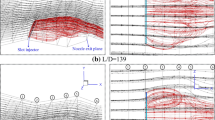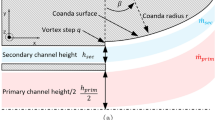Abstract
The present study is to explore an active mass flow control technology for an emerging bypass dual throat nozzle. A new arc-shaped bypass system has been applied to replace the previous V-shaped bypass for the bypass dual throat nozzle, which can decrease the total pressure loss significantly. The bypass passage has a contraction part with a variable area ratio. The vector control effectiveness is discussed with different contraction area ratios of the bypass passage. The obtained results reveal that friction choking and geometry choking play crucial roles to affect the bypass mass flow, respectively. When the bypass passage is fully open, the choking location of the bypass flow occurs at the bypass exit, owing to the viscous boundary layer along the constant area passage. A contraction area ratio less than 0.5 does not change the choking position of the bypass flow, because the viscous boundary layer is larger than the geometry contraction height. While the contraction area ratio reaches or exceeds 0.5, the geometry choking takes place in the contraction section. The vectoring angle and bypass mass flow ratio decrease with an increase in the contraction area ratio, whereas thrust coefficient, thrust efficiency, and total pressure loss increase.
Similar content being viewed by others
Abbreviations
- A e :
-
Exit area
- AR :
-
Area ratio
- C f :
-
Thrust coefficient
- F h :
-
Horizontal force
- F b :
-
Ideal bypass flow thrust
- F i, p :
-
Ideal mainstream thrust
- F r :
-
Real force
- F v :
-
Vertical force
- H 1 :
-
Nozzle inlet height
- H b :
-
Bypass height
- H bt :
-
Bypass throat height
- H e :
-
Nozzle exit height
- H t :
-
Nozzle throat height
- L d-c :
-
Cavity length
- \(\dot m\) :
-
Total mass flow rate
- \({\dot m_b}\) :
-
Mass flow rate through the bypass passage
- \({\dot m_p}\) :
-
Mass flow rate through the nozzle
- M :
-
Mach number
- NPR :
-
Nozzle pressure ratio (P0/Pb)
- P 0 :
-
Stagnation pressure
- P b :
-
Back-pressure
- P e :
-
Area-weighted average pressure
- P w :
-
Static pressure on the bottom cavity wall
- R g :
-
Gas constant
- T 0 :
-
Stagnation temperature
- U ex :
-
Horizontal velocity
- U ey :
-
Vertical velocity
- X :
-
Axial distance
- η :
-
Thrust efficiency
- ρ :
-
Density
- γ :
-
Specific heat ratio
References
K. X. Wu, T. H. Kim and H. D. Kim, Sensitivity analysis on counter-flow thrust vector control with a three-dimensional rectangular nozzle, Journal of Aerospace Engineering, 34(1) (2020) 04020107.
H. J. Hollstein, Jet tab thrust vector control, Journal of Spacecraft and Rockets, 2(6) (1965) 927–930.
H. G. Sung and Y. S. Hwang, Thrust-vector characteristics of jet vanes arranged in x-formation within a shroud, Journal of Propulsion and Power, 20(3) (2004) 501–508.
S. R. Wassom, L. C. Faupell and T. Perley, Integrated aerofin/thrust vector control for tactical missiles, Journal of Propulsion and Power, 7(3) (1991) 374–381.
F. S. Kong, Y. Z. Jin and H. D. Kim, Thrust vector control of supersonic nozzle flow using a moving plate, Journal of Mechanical Science and Technology, 30(3) (2016) 1209–1216.
R. F. Cong, Y. D. Ye, Z. L. Zhao, J. Q. Wu and C. F. Zhang, Numerical research on jet tab thrust vector nozzle aerodynamic characteristics, Journal of Physics: Conference Series, 1300 (2019) 1–6.
R. Cavalleri, W. Tiarn and H. Readey, Thrust vector control using movable probes, Proc. 28th Aerospace Sciences Meeting, Reno, Nevada, USA (1990) 1–12.
R. Chouicha, M. Sellam and S. Bergheul, Effect of reacting gas on the fluidic thrust vectoring of an axisymmetric nozzle, Propulsion and Power Research (2020) 1–15.
S. S. Das, J. C. Páscoa, M. Trancossi and A. Dumas, Computational fluid dynamic study on a novel propulsive system: ACHEON and its integration with an unmanned aerial vehicle (UAV), Journal of Aerospace Engineering, 29(1) (2016) 04015015.
F. W. Burcham Jr., G. B. Gllyard and P. A. Gelhausen, Integrated flight-propulsion control concepts for supersonic transport airplanes, NASA Technique Memorandum (1990) 101728.
J. Y. Heo and H. G. Sung, Fluidic thrust-vector control of supersonic jet using coflow injection, Journal of Propulsion and Power, 28(4) (2012) 858–861.
K. X. Wu, H. D. Kim and Y. Z. Jin, Fluidic thrust vector control based on counter-flow concept, Proceedings of the Institution of Mechanical Engineers, Part G: Journal of Aerospace Engineering, 233 (2018) 1412–1422.
K. X. Wu and H. D. Kim, Numerical study on the shock vector control in a rectangular supersonic nozzle, Proceedings of the Institution of Mechanical Engineering, Part G: Journal of Aerospace Engineering, 233(13) (2019) 4943–4965.
R. Y. Deng and H. D. Kim, A study on the thrust vector control using a bypass flow passage, Proceedings of the Institution of Mechanical Engineering, Part G: Journal of Aerospace Engineering, 229(9) (2015) 1722–1729.
P. J. Yagle, D. N. Miller, K. B. Ginn and J. W. Hamstra, Demonstration of fluidic throat skewing for thrust vectoring in structurally fixed nozzles, Journal of Engineering for Gas Turbines and Power, 123(3) (2001) 502–507.
J. D. Flamm, K. A. Deere, M. L. Mason, B. L. Berrier and S. K. Johnson, Design enhancements of the two-dimensional, dual throat fluidic thrust vectoring nozzle concept, 3rd AIAA Flow Control Conference, San Francisco, California, USA (2006) 1–27.
R. Gu, J. Xu and S. Guo, Experimental and numerical investigations of a bypass dual throat nozzle, Journal of Engineering for Gas Turbines and Power, 136 (2014) 084501.
R. Gu and J. Xu, Dynamic experimental investigations of a bypass dual throat nozzle, Journal of Engineering for Gas Turbines and Power, 137 (2015) 084501.
Y. S. Wang, J. L. Xu, S. Huang, Y. C. Lin and J. J. Jiang, Computational study of axisymmetric divergent bypass dual throat nozzle, Aerospace Science and Technology, 86 (2019) 177–190.
M. H. Hamedi-Estakhrsar and H. Mahdavy-Moghaddam, Experimental evaluation and numerical simulation of performance of the bypass dual throat nozzle, Proceedings of the Institution of Mechanical Engineering, Part G: Journal of Aerospace Engineering (2020).
M. H. Hamedi-Estakhrsar, M. Ferlauto and H. Mahdavy-Moghaddam, Numerical study of secondary mass flow modulation in a bypass dual-throat nozzle, Proceedings of the Institution of Mechanical Engineering, Part G: Journal of Aerospace Engineering (2020).
Y. S. Wang, J. L. Xu, S. Huang, Y. C. Lin and J. J. Jiang, Experimental and numerical investigation of an axisymmetric divergent dual throat nozzle, Proceedings of the Institution of Mechanical Engineering, Part G: Journal of Aerospace Engineering, 234(3) (2020) 563–572.
Acknowledgments
The work is supported by the National Research Foundation of Korea (NRF) grant funded by the Korea government (MSIP) (No. NRF-2016R1A2B3016436).
Author information
Authors and Affiliations
Corresponding author
Additional information
Kexin Wu received his Double M.S. degrees in Mechanical Engineering from Zhejiang Sci-Tech University, China & Andong National University, Republic of Korea, in March 2018. He obtained his Ph.D. degree in Mechanical Engineering from Andong National University, Korea, in February 2021. Currently, Dr. Wu is working as an Associate Professor at Zhejiang Sci-Tech University, China. His research interests involve thrust vector control, shock wave detachment criterion, pseudo-steady shock wave reflection, heat transfer, and fluid machinery.
Heuy-Dong Kim received his Ph.D. from Kyushu University, Japan, in 1991. Dr. Kim is currently a Full Professor at the Department of Mechanical Engineering in Andong National University, Korea. Professor Kim is interested in research areas related to compressible flows including shock wave turbulent boundary layer interactions, thrust vector control, unsteady internal flows, shock tube & supersonic wind tunnel technologies, fluid machinery of high-speed flows, the medical applications of the shock wave, and the supercritical fluid dyeing process of textiles.
Rights and permissions
About this article
Cite this article
Wu, K., Kim, H. A fluidic thrust vector control using the bypass flow in a dual throat nozzle. J Mech Sci Technol 35, 3435–3443 (2021). https://doi.org/10.1007/s12206-021-0716-8
Received:
Revised:
Accepted:
Published:
Issue Date:
DOI: https://doi.org/10.1007/s12206-021-0716-8




